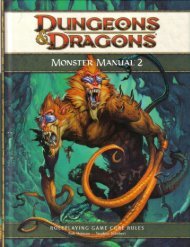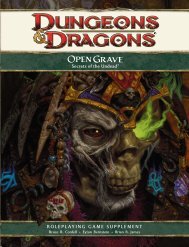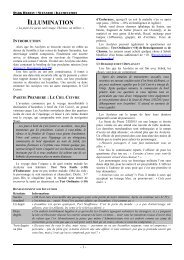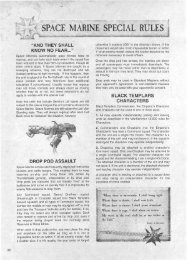Create successful ePaper yourself
Turn your PDF publications into a flip-book with our unique Google optimized e-Paper software.
describe every ingredient of a stew after ingesting asingle large mouthful.Jaws and TeethAs with a crocodile, the muscles that close a dragon’sjaw are more powerful than the ones that open it—yetonly the mightiest foe could hope to hold a dragon’sjaw shut if a dragon wants to open it. The teeth, alsoresembling those of a crocodile, include fangs fortearing and puncturing, incisors for severing fleshfrom bone, and a series of molars for gripping andgrinding.The jaw can also unhinge, stretching a dragon’smaw to massive proportions similar to the way asnake’s jaws unhinge. Dragons rarely display thisability, because they use it only to bite larger foes orto swallow prey too tough to be torn into smaller bits.The throat can stretch wide enough to accommodateanything the unhinged jaws can encompass, thoughswallowing something so large that a dragon mustunhinge its jaw is a painful experience.A dragon’s teeth and fangs consist of a hard substancemore closely related to the substance of adragon’s bones (see “Skeletal System”) than to theenamel and dentin that comprise the teeth of mostcreatures. Similarly, the interior of the tooth resemblesmarrow more than it does pulp.A dragon grows a new set of teeth each time itincreases in size. Between these periods, if a dragonloses a tooth, it has to do without unless it has ameans of healing magically.Spines, Claws, and HornsAll <strong>dragons</strong> have some combination of protrusions inthe form of spines, claws, horns, or all three. Theseprotrusions are made of a substance similar to thatof <strong>dragons</strong>’ teeth. They are not keratinous, as are thehorns of most horned animals, nor have they thesame composition as dragon bones, though they’reclose.Spines are anchored in muscle, connected to theskeleton by a series of ligaments. Claws and hornsconnect directly to the skeleton. Horns and spinesgrow as a dragon grows. Its claws, like its teeth, fallout and regrow when a dragon increases its size.A dragon’s feet have both reptilian and aviancharacteristics. A foot normally has three forwardfacingclaws plus a single claw near the rear of thefoot, though a significant minority of <strong>chromatic</strong><strong>dragons</strong> has four forward-facing claws. The rear clawnormally faces backward when a dragon is walkingor running, but it can twist forward to serve assomething akin to an opposable thumb. Although therear claw is not fully prehensile or as dexterous as ahuman hand, it does allow a dragon to grip objectsand even to use tools or writing styluses if they’reproperly sized and designed for draconic use.ScalesThe texture of a dragon’s hide depends, in part, on adragon’s variety. For instance, a typical black dragon’souter layer of scales feels rough and leathery, like thatof an alligator, whereas a green dragon’s scales generallyfeel smoother, like hardened snakeskin. Thesetendencies are not absolute. For example, the hides ofblack <strong>dragons</strong> from different bloodlines might havemarkedly different textures.In any case, individual scales are more or lessthe same. The way they fit together determines theskin’s texture. Larger scales, such as those that coverthe head, neck, and back, connect to the skin at oneend and overlap neighboring scales at the other. Thisarrangement creates a layer that resembles scalearmor or shingles on a roof. Smaller scales, such asthose that cover a dragon’s underside, rest side by siderather than overlapping.Dragon scales are slightly more flexible than steeland substantially stronger, making them perfectarmor. Unfortunately for those who desire to makearmor from dragon scales, harvesting scales is difficult,and armor constructed from such scales lastsonly a few weeks after it is taken from a living dragon.Everyone knows stories of unique sets of magic armormade of dragon scales, but it might be impossible toconstruct a mundane armor from harvested scaleswithout a long-lost creation ritual.A dragon never sheds its skin, since its scales growslowly throughout the course of its life. It occasionallyloses individual scales through injury or illness oras a result of natural molting. These patches remainbare for a few months at most, before replacementscales grow large enough to fill the gap.WingsA <strong>chromatic</strong> dragon’s wings are simple in structure.Each consists of a membrane of thin hide stretchedacross a structure of lightweight bones, like a bat’swing.Each wing is large enough that nothing short ofnumerous large tears can threaten a membrane’sintegrity. As a result, it’s difficult to injure a dragon soseverely that it cannot fly. Such tears heal relativelyquickly.Internal AnatomyMany details that differentiate <strong>dragons</strong> from othercreatures are internal. Although a dragon’s scales andflesh somewhat resemble those of reptiles, a differentstory unfolds underneath.In the following sections, numbers in parenthesesrefer to the indicated locations on the accompanyingillustrations.8CHAPTER 1 | Dragon Lore









